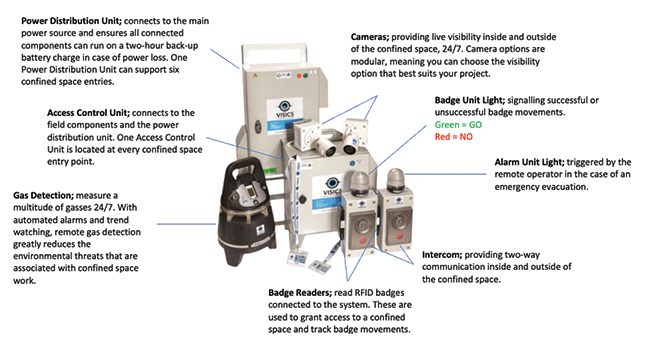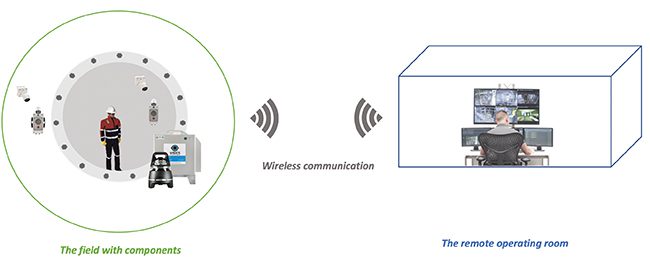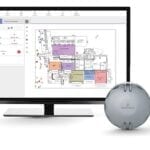It’s becoming harder and harder for managers to find the skilled labor needed to operate and maintain power plants. That’s why utilizing technology to enhance safety and efficiency is so important. Digital confined space monitoring is an innovative tool that reduces the labor burden while improving monitoring capabilities—a literal win-win for system users.
For years leading up to the pandemic, power industry observers were warning of the need to attract and retain skilled labor. In 2019, the Global Energy Talent Index reported that the labor shortage continued to grow due to multiple factors, including retirement and job switches to more attractive industries. COVID-19 only made matters worse, as laborers left the workforce with no intention of returning.
Technology to the Rescue
But, like many other challenges brought about by the COVID pandemic, labor ambiguity, costs, and safety measures can all be combatted with digital technologies that allow for greater flexibility, reduced head count, and increased efficiency. Take digital confined space monitoring (DCSM), for example. Traditionally, confined space monitoring has been performed with one safety attendant monitoring one confined space (1-1 ratio). This traditional safety attendant is generally responsible for the following:
- Checking permits before entry.
- Verifying personal protection equipment (PPE) requirements.
- Documenting entry and exit times.
- Alerting rescue personnel should an incident occur.
- Documenting any other notable activity.
Due to a lack of information from inside the confined space and historical work methods, traditional safety attendants are limited in their means to act. Should an accident occur within a confined space, there is little means to alarm contractors inside and littler information available to guide rescue personnel. Consequently, it is also difficult to concretely identify and learn from the incident.
With these working methods, sites planning for turnarounds must account for not only one safety attendant to every confined space, but also for standby firewatchers and rescue personnel, all whilst needing to reduce headcount, contact, and costs in the growing wake of the labor shortage. This is just a fraction of the new challenges faced by turnaround planners. So, how can contractors, planners, and operators emerge as industry leaders post-pandemic? Well, now, more than ever, may be the time for energy industries to seize digitalization opportunities.
Setting Goals
To find solutions to labor shortage challenges, the first step is to identify your objectives. Common objectives shared amid the growing labor shortage during the global pandemic include:
- Cutting costs.
- Increasing efficiency.
- Decreasing headcount.
- Increasing safety.
These objectives can seem contradictory at first, especially when applying traditional business rationale, but when innovative thinking is applied and technology is factored in, the possibilities are endless. The trick is to simplify what your tangible objectives are. Digitalization, data, and technology can all be intimidating and complicated words—the results should not be. When thinking back to the example of confined space monitoring, achieving the mentioned objectives under today’s pressures can be relatively simple with DCSM technology.
DCSM is the process of combining people and technology to make confined space work more insightful, safe, and efficient. A traditional DCSM system works by combining a series of components, such as cameras, alarms, and sensors, inside and outside of the confined space. The equipment is used to collect data from the field (Figure 1). Data collected from the field components is then transmitted, in real time, to the monitoring operator station for remote monitoring capability (Figure 2).
 |
|
1. Digital confined space monitoring (DCSM), remote gas detection, access control and management, and people and asset tracking are achievable through a series of modular components that integrate into the VISICS system. Courtesy: Mobile Shutdown System B.V. |
 |
|
2. DCSM is achieved through wired components in the field communicating wirelessly to a remote control room. Courtesy: Mobile Shutdown System B.V. |
DCSM technology has been around since early 2007 when a small team of industrial partner companies in Western Europe started innovating based on the safety needs of a few industrial clients. Later, in 2009, this technology was recognized as VISICS and deployed worldwide to the most forward-thinking industrial organizations.
The primary goal for DCSM is to protect confined space entry personnel from the risks and hazards associated with confined space work 24/7, but the subsequent results of an installed system go much further. Once installed, clients can enjoy:
- ■ Two-way communication inside and outside of the confined space with the push of a button.
- ■ Live visuals inside and outside of the confined space, even in dark conditions.
- ■ Access control with event logs and smart rules, such as the ability to limit the number of personnel allowed in a space.
- ■ Remote alarm and evacuation capabilities for one or more confined spaces at a time.
- ■ Remote supervision from any approved device.
- ■ Reduced manpower on-site by using two operators for every 12 confined spaces (2-12 ratio vs. 1-1).
- ■ Optimized productivity and efficiency management.
- ■ Reports on safety events.
- ■ Data analytics for future planning.
This technology has seen an uptick in interest over the last year, specifically for the value proposition of personnel reduction on site. Companies that were once behind the adoption curve of DCSM are now slowly adopting the proven technology as a “new way of doing business.” In respect to technology adoption, the COVID-19 pandemic has accelerated the change in behavior toward technology that can help industrial organizations soften the financial impact of the external events at play. According to McKinsey & Company, COVID has actually accelerated digital adoption by seven years.
Two of the primary reasons companies in the U.S. and Western Europe are adopting DCSM solutions is to account for the growing labor shortage and to drive costs down. With DCSM, organizations reduce costs by reducing labor.
A 21-Day Turnaround Example
To better understand the benefits DCSM can provide, imagine the following scenario based on a 21-day, around-the-clock turnaround. In this example, we’ll assume the facility has 12 confined spaces that need to be entered during this short time frame.
With the traditional approach, a minimum of 24 safety attendants would be needed when accounting for day and night shift—12 confined spaces with two safety attendants required per space. With DCSM, the same project would typically require four operators total, accounting for day and night shift. This is because with most DCSM systems 12 confined spaces can be monitored by two operators: one roving field operator and one operator monitoring video feeds, answering intercom calls, and managing other responsibilities.
Assuming one traditional safety attendant costs approximately $35.00 all-in per hour, a client is quickly looking at a daily cost of $10,080 dollars or a total project cost of $211,680. DCSM, depending on the provider, can vary in pricing and features available; however, operating on a general assumption, a client could expect to pay about $23 per hour, per confined space, which adds up to a daily price of $6,624 for 12 spaces, or a total project cost of $139,104. The difference between the two is a financial savings of 34% when using DCSM to reduce headcount, and increase safety and efficiency. The cost savings may vary based on provider, scope of project, and location.
DCSM Implementation
Oftentimes, new adopters of DCSM technology are keen on the labor and monetary savings, but question the implementation of such a system. Two of the most commonly asked questions are: “Who implements the system?” and “Who monitors the system?”
The answers could vary slightly depending on the technology provider, but typically suppliers have a team to advise, implement, and operate DCSM projects. That means clients do not have to worry about sourcing labor and training them on the system—that is taken care of.
In the case of VISICS, a global trusted partner network has been built across more than 15 countries to help implement DCSM projects. Operators are trained in a blended learning format through a global academy program to ensure high quality standards are met everywhere in the world.
It’s important to recognize that like many solutions on the market, not all DCSM systems are equal. Solutions available can include various components, functionalities, integrations, reporting capabilities, and infrastructure designs. When considering DCSM solutions, it is first and foremost important to test your options. Participate in operational demonstrations, and get the look and feel of various solutions. Ask questions that cover a range of domains—operational questions, health and safety questions, information technology and reliability questions, and so forth.
Second, it’s important to understand why you are using the system. Are you trying to reduce labor, limit contact, track productivity, or something else? In markets such as India, DCSM is primarily being used today as a tool to increase safety and sustainability efforts; whereas, in the U.S., DCSM is more often used to reduce labor and increase safety and efficiency.
Third, identify your goals and the scope of the project. What do you hope to see? What are your expectations from the technology? How do you want your contractors and stakeholders to interact with the technology? Think about the system’s ease of use and various value propositions, and ensure the desired objectives are achieved.
Fourth, get a system expert to perform a site needs assessment. This is a critical step in developing the system design. Every site is unique and thus calls for a tailored approach.
Fifth, use the system. Doing an actual implementation or a small-scale pilot will give you more tangible insight into how the system works, and how it can add value to your team and organization as a whole.
And last, but not least, review the outcomes. A thorough post-implementation review will shed light on any grey areas of the project, and serves as a moment to reflect and refine the approach for the future.
In the planning season ahead, where skilled labor seems to be growing in scarcity and cost, these six steps can be used as a guideline to evaluate and implement technology successfully. After all, digital openness and adoption is a key factor in becoming a leader of operational efficiency post pandemic.
—Bridget Shelton (bridget.shelton@access-technology.nl) is the global marketing manager for Netherlands-based Access Technology Group, parent company of Mobile Shutdown System B.V., maker of VISICS—a safety and efficiency solution designed to improve maintenance turnarounds and shutdowns.











